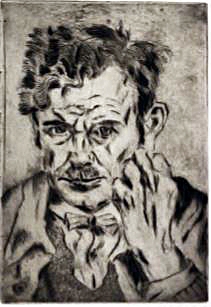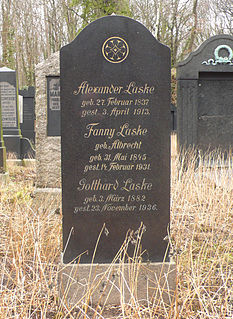
Paul Spiegel was leader of the Central Council of Jews in Germany and the main spokesman of the German Jews. He was widely praised for his leadership of the German Jewish community, which had grown from the remnants left by the Nazis into the third largest Jewish community in western Europe.

Friedrich Adler was a German artist, designer and academic. He was renowned for his accomplishments in designing metalwork in the Art Nouveau and Art deco styles; he was also the first designer to use bakelite. He designed using a wide variety of objects and materials.
Menachem Birnbaum, was an Austrian Jewish book illustrator and portrait painter.

Arno Nadel was a Lithuanian musicologist, composer, playwright, poet, and painter.

Hermann Simon is a German historian who was for 27 years director of the Foundation "New Synagogue Berlin - Centrum Judaicum".

Margarete Hedwig Zuelzer was a German biologist and zoologist specializing in the study of protozoa.

The Theresienstadt Papers are a collection of historical documents of the Jewish self-government of Theresienstadt concentration camp. These papers include an "A list" of so-called "prominents" interned in the camp and a "B-list" created by the Jewish Elders themselves. The Theresienstadt papers include two albums with biographies and many photographs, 64 watercolors and drawings from prisoners in Theresiendstadt, and the annual report of the Theresienstadt Central Library. The papers were preserved at the liberation of the camp in May 1945 by Theresienstadt librarian Käthe Starke-Goldschmidt and later loaned to the Altona Museum for Art and Cultural History in Hamburg by her son Pit Goldschmidt. The collection was opened for viewing by the public in 2002 at the Heine Haus branch of the Altona Museum.

Salomon Korn is a German architect and an Honorary Senator of University Heidelberg. Since 1999 he serves as Chairman of the Jewish Community of Frankfurt am Main and since 2003 as Vice president of the Central Council of Jews in Germany.

Heinemann Vogelstein was a German rabbi and leader of Reform Judaism in Germany.

Heinrich Nauen was a German Expressionist artist. He created oils, watercolors, and prints; as well as murals and mosaics. A large part of his output consists of landscapes and floral still-lifes.

Franz Monjau was a German Expressionist painter and art teacher.

Peter Ludwigs was a German sculptor and Expressionist painter. He is primarily known for his later, Anti-fascist paintings.
Jüdische Rundschau was a Jewish periodical that was published in Germany between 1902 and 1938. It was the biggest Jewish weekly publication in Germany, and was the organ of the Zionist Federation of Germany.

Paula Salomon-Lindberg was an internationally renowned German classical contralto before the Second World War. She was specialised in Lied, oratorio and cantata, but occasionally also performed opera.

The art collection of Ismar Littmann (1878–1934), a German lawyer who lived in Breslau, comprised 347 paintings and watercolors and 5,814 drawings from artists such as Lovis Corinth, Max Pechstein, Erich Heckel, Max Liebermann, Käthe Kollwitz, Lucien Adrion, and Otto Mueller.

Rahel Szalit-Marcus was a Jewish artist and illustrator. Born Rahel Markus in Telz [Telsiai] in the Kovno region of Lithuania, then part of the Russian Empire, she was active in Berlin during the Weimar Republic and in Paris in the 1930s. She was best known for her illustrations of East European Jewish subjects. Szalit-Marcus perished at Auschwitz in August 1942.
Ilse Häfner-Mode was a German-Jewish artist of what German commentators sometimes term the "lost generation" . Most of her work, which consists both of oil paintings and of watercolours, latterly sometimes enhanced through the artist's own embroidery using silk thread, is held in private collections. The organisers of an exhibition devoted to her work in 2013 were nevertheless able to get hold of approximately 100 of her paintings, on loan, from around 30 collectors.

Albert Katz, also known by the pen name Ish ha-Ruaḥ, was a Polish-born rabbi, writer, and journalist.

Gotthard Laske was a German confectioner, bibliophile, and patron of the arts.

Julie Elias was a German fashion journalist and author of cookbooks, which also dealt with Jewish cuisine. She was worldly, highly educated, and during her lifetime was known beyond the borders of Germany as a culinary salonnière and successful writer. In 1938, persecuted as a Jew, she had to flee Germany. After the destruction of European Jewry in the Holocaust, there were hardly any traces of her left in the public memory.




















